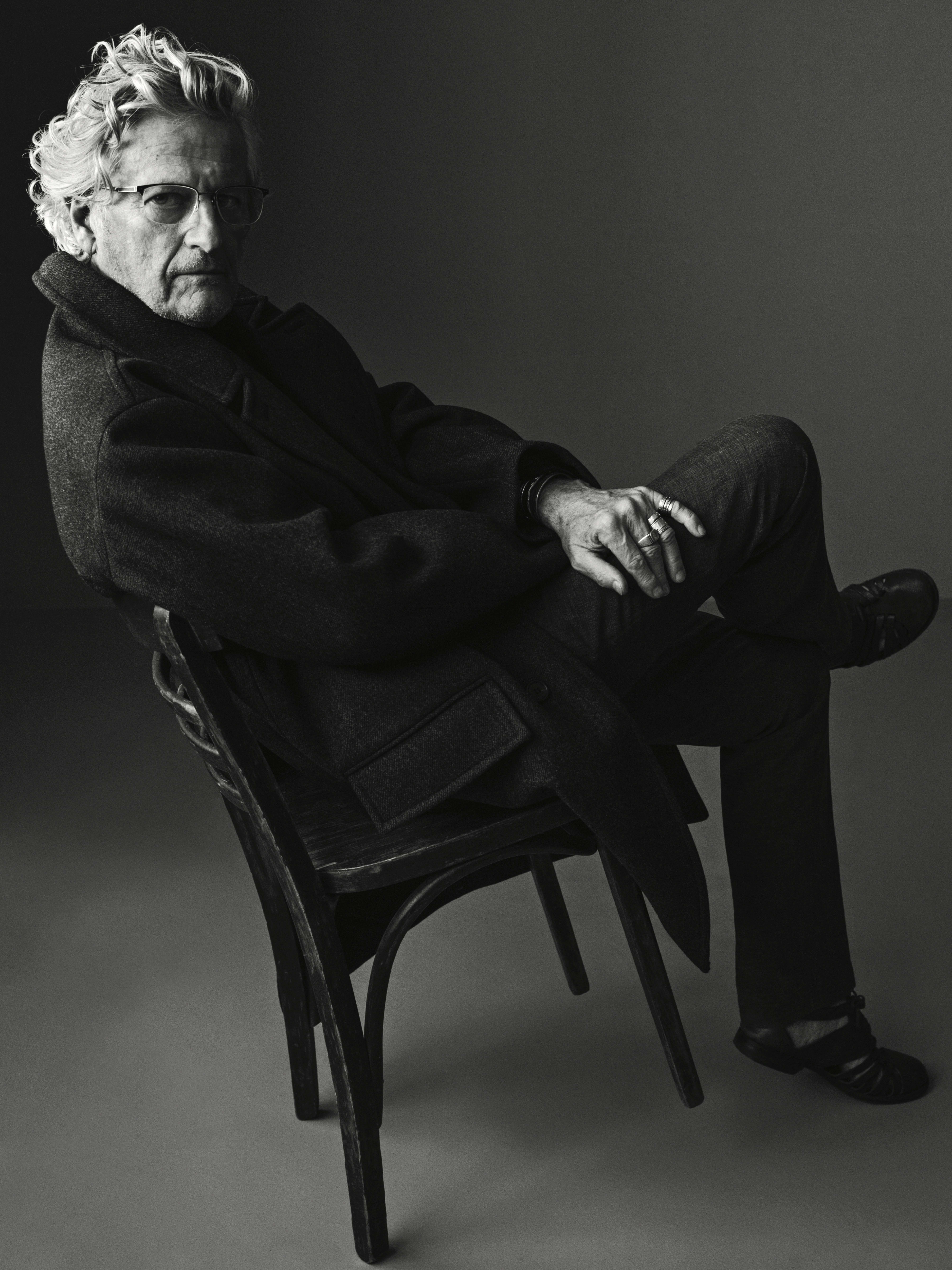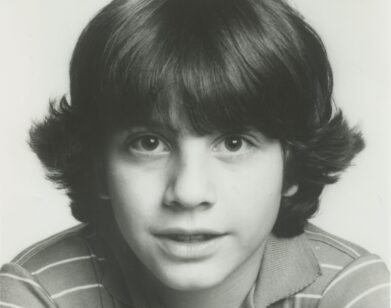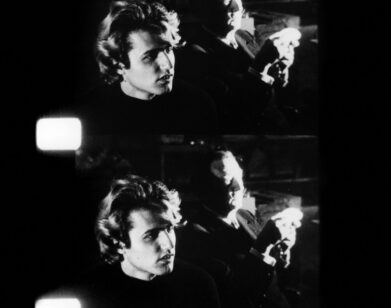The New York video artist who caught Warhol’s Factory on tape
Michel Auder has seen the world. Raised in the north of France (like in Coal Miner’s Daughter, as he once described his solitary childhood), the 73-year-old artist began his career as a commercial fashion photographer in Paris. He spent a brief time as a combat photographer in Algeria before garnering support as a filmmaker from the leftist film collective Zanzibar Group in the late 1960s. But it was at a screening of Andy Warhol’s The Chelsea Girls in 1968 where a meeting with the pop artist emboldened his own self-taught approach to multimedia art—and indirectly introduced him to the Warhol superstar Viva, whom he married in Las Vegas soon after.
Some of Auder’s early works have been lost forever; many, however, have survived. In his experimental 1970 film Cleopatra, the Egyptian queen’s zoo has been transposed into a pet enthusiast’s room at New York’s Chelsea Hotel; the desert is made of Manhattan snow; and characters speed by on snowmobiles. Filmed on 16mm and operatic in scale, Auder’s version of the Cleopatra story foreshadowed his decades of making art out of his own lived experience. Another of Auder’s early films, Keeping Busy (1969), responded to Warhol’s blank, impassive filmmaking style with a celebratory “home movie” of superstars on holiday. The title suggests one of the artist’s manic talents; together, his works create a cohesive structure out of a flurry of uncomposed moments, out of the disorder of time, out of all of the things that dissolve when you’re living your life. Auder’s works are records of doing just that.
When we met as Lower East Side neighbors in 1998, Auder was living at 188 Orchard Street, where he made a series of work by the same name; the 188 Orchard Street (2001) photographs were meticulously culled from 40 hours of intimate scenarios shot on video by the artist in his own apartment. His photographic works, like his film practice, rely on rigorous editing from an extensive amount of material. Internalizing the influences of his early contemporaries, ranging from the reductive tendencies of Warhol to the naturalistic, intimate styles of Frederick Wiseman and Robert Frank, Auder developed a unique signature that fluctuates between closeness and distance, between insider and outlaw. Auder has, perhaps, always wanted it both ways, and found that it was possible using the medium of video in the late ’60s and ’70s: he could record everything around him and do something with it later. Maybe.
LIA GANGITANO: You just showed your latest work, The Course of Empire, at Documenta 14. The installation is a compilation of statements and texts you’ve been working on for a while, right?
MICHEL AUDER: I’d been working on it for a whole year. They gave me an abandoned train station in which to show the work, so the space was enormous. My idea was to use very big screens. And you have to come up really close to read the text. If you look at it from far away, it doesn’t make the same sense. The main text is from the geographer and explorer Alexander von Humboldt. Basically, it’s from his time exploring what is now South America, when it was still being colonized by the Spanish. He described how the slaves were being treated and the way the colonizers were acting, as well as the temperature of the ocean, the height of the mountains, all the animals he observed. The piece is a way of critiquing historical development and our moral or spiritual position in the world.
GANGITANO: Some might think this is a departure for you. There’s a general misperception that your work tends to be observational or voyeuristic and that it comes directly out of your own life.
AUDER: I don’t see my work as being all that personal. I’ve used my personal experience in the world, of course, or at least my way of looking at the world. But I think that’s changed as I’ve gotten older. This piece is more a statement about “the course of empire,” a title I took from the Hudson River School painter Thomas Cole. He did five paintings that trace the course of empire [The Savage State (1834), The Pastoral or Arcadian State (1834), The Consummation of Empire (1835–36), Destruction (1836), Desolation (1836)]. It was his way to criticize the time he was living in. In the last painting, everyone is killing each other. It was actually the curator of Documenta 14, Adam Szymczyk, who introduced me to Cole’s series a few years ago. He thought there were a lot of similarities with my earlier pieces.
GANGITANO: Yes, like how your work goes back to 1968 when you shot the Sorbonne student protests [this footage has been lost]. A lot of people in the United States are in a state of shock today that their government suddenly hates them or wants them to die. But you’ve experienced that before. You’ve charted that course of mayhem.
AUDER: Yeah, but it’s still frightening, the people who Trump has brought to the surface. That hatred has always existed in the United States, it’s not something new, but now it’s supported by the government. It seems like it’s only going to get stronger and stronger.
GANGITANO: I’ve learned a lot about human nature from your work over the decades—sometimes even the less attractive aspects of certain people. Like your piece Chelsea Girls With Andy Warhol, where Viva has just had your daughter, Alex, and Andy doesn’t want to visit for various reasons.
AUDER: Right. That was made starting in 1971 when my daughter was born, and we lived in the Chelsea Hotel. I was introduced to Andy through Viva. Andy would call Viva every day.
GANGITANO: And you were recording those phone calls.
AUDER: We would record them and so would Andy. We set up a scene where Brigid [Berlin] called Andy and said, “We’re taping you, and Viva is here.” Viva had just had the baby four days earlier, and there’s a not-very-nice segment of Andy talking about her. But that’s real life. You sometimes say things over the phone to friends that you don’t really mean.
GANGITANO: It’s certainly not a glamorous view. But it does reveal an aspect of his personality, even if it’s that Warhol, with his questionable views, was such a product of his time.
AUDER: He had a lot of questionable views. [laughs]
GANGITANO: But that was a big part of your work—you weren’t seeking out material. It was there around you.
AUDER: Yeah, it flowed in. The ordinariness became, in a way, a revelation. It also shows how little people have changed from the 1970s to now.
GANGITANO: When I moved to New York in 1997, you were one of the first people I met. You, Rene Ricard, and Taylor Mead, who was living across the street on Ludlow. It still had that feeling of all these legendary figures being around in a really normal way. Do you feel like New York has changed a lot?
AUDER: Well, I hope there are young artists moving to the city and doing exciting things. Or maybe they’re doing interesting things now in the corners of the dark web. I don’t know. I’m 73, and I am not really looking to handle that world right now. I’m just trying to live the final years of my life. [laughs] New York has definitely changed, but the whole world has changed. It’s almost like we’re back in the Middle Ages, where people with money live in cities like they are these protected castles and only leave them to travel to the coast of Italy or a nice town in Mexico. I moved out to Brooklyn after living in Manhattan for 40 years. I remember being 19 or 20 and people telling me that the world wasn’t like it used to be. And I’d be like, “Oh yeah, it isn’t like it was during World War II!”
GANGITANO: One of the things that you capture in your work is how New York has physically changed. I’m thinking particularly of your video Portrait of Alice Neel [1976–82], in which you show everywhere from the mayor’s mansion to the streets of Harlem.
AUDER: Alice and I became friends in 1975, which wasn’t that long before her death. I used to visit her once a week until she got too sick. I filmed her all the time because she was an incredibly talkative person. She had so many opinions on an incredible array of subjects. And what was really special was that she allowed me to film her while she painted and while people were posing for her. We also went on vacation together to Bermuda. A collector who was the heir to General Motors or something was a friend of hers and he’d invited her down. I also accompanied her to a few of her talks in Maine and Philadelphia. I’m happy that film is getting a new audience these days.
GANGITANO: Was Alice encouraging of your work?
AUDER: She gave me the sense that I wasn’t a complete loser because, first of all, she was interested in video. So she would watch a lot of my work. I’d bring video to her studio, and she’d watch it with interest. She also acted in some of my video work. She was encouraging at a time when I was extremely discouraged. I felt like I was going nowhere. There really weren’t many outlets for video back then. Alice would always speak about how, in the early ’60s, she sold her work on the street in the Village. It took her a long time to be taken seriously as well—and it really didn’t happen until late in her life. In that film I did, you can see that her studio is pretty dilapidated. She was still just getting by, cooking on a burner while pigeons were crashing into her window. She lived in that apartment on 127th Street for 20 years.
GANGITANO: There was a different idea back then of what it meant to be a successful artist. It’s interesting that you used the art world itself as your material.
AUDER: I’m in the art world so I use the art world a lot—or art world people as actors. I’ve also used television to criticize what I see on television. And now a lot of my work is made from the internet and a lot of it is made on my phone. I tend to use the technology that appears in my life, that is on hand and available to me. Technology changes so much that it has forced me to adapt. I remember I would have to scramble so much when I was working with reel-to-reel film. You don’t have to scramble like that when you’re working on digital. If the machines had stayed the same, I’d probably be more refined in my practice, the way a painter is. But I keep jumping along with technology.
GANGITANO: You’re using self-obsolescing tools.
AUDER: Some of what we have in 2017 I wanted desperately in 1970 because working with tape and those old machines would really slow me down. I would have to concentrate so hard to get the effect I wanted. It was painful. It’s still painful. [laughs]
GANGITANO: One of my favorite pieces is Viva Book Signing [1970]. For that, you probably have a Sony Portapak or some large camera, and Viva is introducing you to people, and the camera is going up and down as you shake hands with people. You were basically using that large, heavy camera like an iPhone. The gesture is not so different.
AUDER: For me, it’s more about how you put the footage together than the technology, because the filming is just the form. But, yes, putting that material together was not easy. Now when I go to an opening and pull out my iPhone, there are 20 other people right next to me with their iPhones out. I have to trust myself that I can bring something back home that I can use and that fits my vocabulary.
GANGITANO: In your early work, you tended to cast your friends—Cookie Mueller, Gary Indiana, Taylor Mead, Eric Bogosian—in loosely scripted roles.
AUDER: I always chose talkative people. And Viva, who was my first wife—we started making films together because she was extraordinarily creative. I was drawn to those people who tended to talk or act differently. The nice thing about using your friends as actors is they trust you. I wouldn’t use footage of people that was destructive to them.
GANGITANO: I know you’re doing the visuals for an upcoming play [On the Royal Road: The Burgher King, written by Elfriede Jelinek and directed by Falk Richter, at the Schauspielhaus Hamburg]. Have you worked in theater before?
AUDER: Not really. Not since maybe the ’60s when I did some production work for an English theater group.
GANGITANO: Have you been going back through your archives?
AUDER: I’ve been trying to, but my studio isn’t big enough to engage in too much at once. I need a bigger studio with two or three stations. I’m supposed to be working on this play, but I keep getting distracted by the archive. I actually have a piece up now for a show on Warhol in Munich. It’s a work called 1967 [2015], which has four screens and plays this footage I shot in the late ’60s that I recently found in my studio. There’s footage of Andy filming in the Factory, and Brigid Berlin is making tit prints in our room at the Chelsea, and there’s Viva in Morocco on vacation, and there’s Pierre Clémenti. There are also parts from my film Cleopatra [1970]. 1967 is playing in a special room at the Brandhorst Museum with a guard at the entrance to keep the children away. [laughs]
GANGITANO: I guess re-sampling from your archive is built into your practice. Nothing is ever final or off-limits, like using pieces from Cleopatra.
AUDER: Right, except that the part I used from Cleopatra was actually cut from the original film because the Cannes Film Festival wouldn’t let me show it. It’s a scene where Gerard Malanga is masturbating. Cannes invited me and Viva to show Cleopatra in 1970, but when we arrived, they told us that scene was too graphic. So I took a pair of scissors and clipped that part out, rolled it up, and put it in my pocket.
GANGITANO: And that’s the film you found? That’s amazing. You never know what you’re going to find in your clothes. So 1967 is comprised mostly of outtakes from your other works?
AUDER: I wouldn’t call them outtakes, but they were left over from editing other works. It was all the stuff from ’67, which is why I called it that.
GANGITANO: Didn’t you make a work a few years ago based on James Baldwin?
AUDER: Yeah, in 2015. I’d known Baldwin since I was 17. He was in Paris and I was hanging around in the same places. We were both friends with a guy who ran a bar that was very famous for American jazz—free jazz it was called at the time. Baldwin hung out in the bar there. I didn’t know him that well because he was fairly reserved, but I was always aware of his presence. So I finally made a piece about him where he’s discussing how the American Dream was created at the expense of the “American Negro.” It’s from his debate with William F. Buckley Jr. in the ’60s. I had text by him in Empire, too, but in the end, I went with Humboldt’s description of the state of slavery in the 18th century. I did this other piece in Berlin recently where I play a “liberal American gentleman farmer.” For that, we got guns, cows, chickens—everything. And then, suddenly, in comes that Leonard Cohen song “Everybody Knows.” You know where he sings, “Everybody knows the war is over / Everybody knows the good guys lost …” And then it cuts to a televised debate with Baldwin.
GANGITANO: Have you shown it?
AUDER: Only once, at midnight in the middle of winter at an enormous old-fashioned theater in Berlin. But I’ve never shown it again. Maybe it’s time.
LIA GANGITANO IS A NEW YORK–BASED GALLERIST, WRITER, AND CURATOR, AND THE FOUNDER OF THE LOWER EAST SIDE ART SPACE PARTICIPANT INC.







